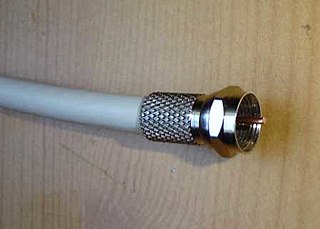
Cable television is a system of delivering television programming to consumers via radio frequency (RF) signals transmitted through coaxial cables, or in more recent systems, light pulses through fibre-optic cables. This contrasts with broadcast television, in which the television signal is transmitted over-the-air by radio waves and received by a television antenna attached to the television; or satellite television, in which the television signal is transmitted over-the-air by radio waves from a communications satellite orbiting the Earth, and received by a satellite dish antenna on the roof. FM radio programming, high-speed Internet, telephone services, and similar non-television services may also be provided through these cables. Analog television was standard in the 20th century, but since the 2000s, cable systems have been upgraded to digital cable operation.

A telephone is a telecommunications device that permits two or more users to conduct a conversation when they are too far apart to be heard directly. A telephone converts sound, typically and most efficiently the human voice, into electronic signals that are transmitted via cables and other communication channels to another telephone which reproduces the sound to the receiving user. The term is derived from Greek: τῆλε and φωνή, together meaning distant voice. A common short form of the term is phone, which came into use almost immediately after the first patent was issued.

Video on demand (VOD) is a media distribution system that allows users to access videos without a traditional video playback device and the constraints of a typical static broadcasting schedule. In the 20th century, broadcasting in the form of over-the-air programming was the most common form of media distribution. As Internet and IPTV technologies continued to develop in the 1990s, consumers began to gravitate towards non-traditional modes of content consumption, which culminated in the arrival of VOD on televisions and personal computers.
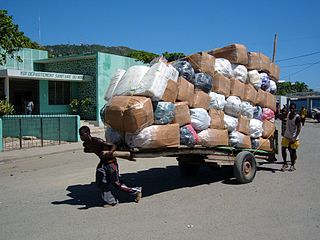
A cart or dray is a vehicle designed for transport, using two wheels and normally pulled by one or a pair of draught animals. A handcart is pulled or pushed by one or more people.
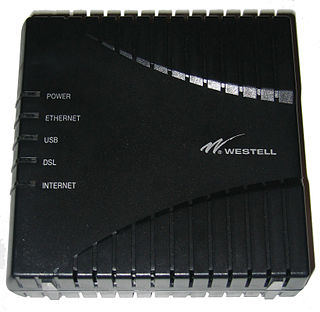
A digital subscriber line (DSL) modem is a device used to connect a computer or router to a telephone line which provides the digital subscriber line service for connection to the Internet, which is often called DSL broadband. The modem connects to a single computer, through an Ethernet port, USB port, or is installed in a computer PCI slot.

A horse-drawn vehicle is a mechanized piece of equipment pulled by one horse or by a team of horses. These vehicles typically had two or four wheels and were used to carry passengers and/or a load. They were once common worldwide, but they have mostly been replaced by automobiles and other forms of self-propelled transport.

This history of the telephone chronicles the development of the electrical telephone, and includes a brief review of its predecessors.

Radio is the technology of signaling and communicating using radio waves. Radio waves are electromagnetic waves of frequency between 30 hertz (Hz) and 300 gigahertz (GHz). They are generated by an electronic device called a transmitter connected to an antenna which radiates the waves, and received by another antenna connected to a radio receiver. Radio is very widely used in modern technology, in radio communication, radar, radio navigation, remote control, remote sensing and other applications.
A force gauge is a measuring instrument used to measure forces. Applications exist in research and development, laboratory, quality, production and field environment. There are two kinds of force gauges today: mechanical and digital force gauges. Force Gauges usually measure pressure in stress increments and other dependent human factors.
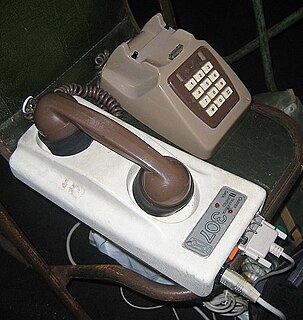
A modulator-demodulator, or simply a modem, is a hardware device that converts data from a digital format, intended for communication directly between devices with specialized wiring, into one suitable for a transmission medium such as telephone lines or radio. A modem modulates one or more carrier wave signals to encode digital information for transmission, and demodulates signals to decode the transmitted information. The goal is to produce a signal that can be transmitted easily and decoded reliably to reproduce the original digital data.

The Dodge WC series, sometimes nicknamed 'Beeps', were a prolific range of light 4WD and medium 6WD military utility trucks, produced by Dodge / Fargo during World War II. Together with the 1⁄4-ton jeeps produced by Willys and Ford, the Dodge 1⁄2‑tons and 3⁄4‑tons made up nearly all of the light 4WD trucks supplied to the U.S. military in WWII – with Dodge contributing some 337,500 4WD units.
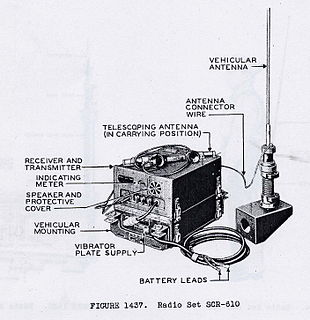
The SCR-610 was a Signal Corps Radio used by the U.S. Army during and after World War II, for short range ground communications, it was standardized 29 Sept. 1941,
Pulse-code modulation (PCM) is a method used to digitally represent sampled analog signals. It is the standard form of digital audio in computers, compact discs, digital telephony and other digital audio applications. In a PCM stream, the amplitude of the analog signal is sampled regularly at uniform intervals, and each sample is quantized to the nearest value within a range of digital steps.

A telephone magneto is a hand-cranked electrical generator that uses permanent magnets to produce alternating current from a rotating armature. In early telegraphy, magnetos were used to power instruments, while in telephony they were used to generate electrical current to drive electromechanical ringers in telephone sets and on operator consoles.
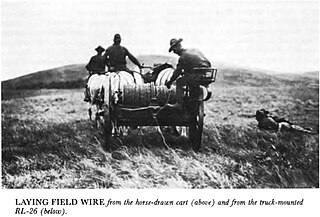
The K-1 cart is a wire cart type K-1. It comprises a 2-wheel reel cart used for the rapid laying and recovering of telephone and telegraph lines in the field. It is completely equipped with a reel, mechanically rotated and controlled, 1 chest with wire-laying equipment, a driver's seat, and appropriate parts and fittings specially designed and used for only on this cart; designed to carry 5 miles of wire, type W-39. It was formerly known as "Wire reel cart, type N".

The K-3 cart is a 2-wheel, strongly constructed wire cart, similar to artillery caissons, but equipped for carrying and reeling out wire; used together with Signal cart, type K-4, to form the wagon formerly called "Pintle wire wagon, model 1910."

The K-4 cart is a 2-wheel strongly constructed signal cart similar to artillery caissons, but equipped for carrying signal equipment; used with the Wire cart, type K-3, to form the wagon formerly called "Pintle wire wagon, M1910".
The K-8 cart was a two-wheel horse-drawn cart used by the U.S. Signal Corps, designed for transporting in the field a large assortment of signalling equipment in the field. The cart's gauge is 5 ft 2 in, the wheel rims 2+1⁄2 inches wide, and the wheel diameters are 5 ft. The body of the cart consists of a large chest surmounted by a driver's seat which is 44 inches wide, 27 inches high, and 5 ft 4 in long. It is mounted upon commercial wagon springs, and the interior is equipped with partitions suitably arranged for separating and holding rigidly in place the parts of equipment, type SE-6.

The K-5 truck is a light automobile truck with a 10 feet 4 inches (3.15 m) wheelbase, standard automobile gauge, and 35 in (89 cm) wheels; length from front of radiator to rear of body 15 feet (4.57 m); equipped with single top; formerly marked with the Signal Corps emblem and the words "Signal Corps, U.S. Army" and also with the name "Maintenance truck No.5" or "Tender for radio tractor No.3".

James Henry Nixon (1802-1857) was an illustrator and painter during the Victorian period, who worked in the firm Ward and Nixon painting stained glass windows. James Henry Nixon was a protégé of Charles Winston, who praised Nixon's work at Westminster Abbey and Church of Christ the King, Bloomsbury. The company Ward and Nixon was followed by Ward and Hughes.

















